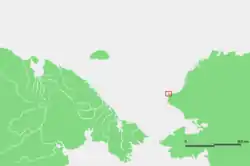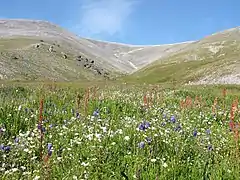Cape Lisburne

Cape Lisburne (Iñupiaq: Uivvaq) is a cape located at the northwest point of the Lisburne Peninsula on the Chukchi Sea coast in Alaska. It is 40 miles (64 km) northeast of the village of Point Hope, part of the Arctic Slope. It is a part of the Chukchi Sea unit of Alaska Maritime National Wildlife Refuge. It is the northwesternmost point of land in Alaska, North America, and based on the International Date Line[lower-alpha 1] the world.
History
The first European to sight this cape was James Cook. He named it on August 21, 1778, and wrote: "The southern extreme seemed to form a point which was named Cape Lisburne."
An early Inupiaq name for the cape was "Uivvaq," generally spelled "Wevok" or "Wevuk". Cape Lisburne was often referred to as "Uivvaq Uŋasiktuq" meaning "distant cape" as opposed to "Uivvaq Qanittuq" (Cape Thompson) meaning "near cape."

The native Inupiaq who lived there were struck by a deadly epidemic and many died along with an Episcopal missionary named John Driggs.[1]
From 1951 to 1983, the United States Air Force maintained a long-range radar and communication facility at Cape Lisburne Air Force Station that was part of the DEW Line network of radar sites along the Alaska North Slope. The Pacific Air Forces Regional Support Center maintains the radar installation today.[2]
| Climate data for Cape Lisburne, Alaska, 1954–1984 normals and extremes | |||||||||||||
|---|---|---|---|---|---|---|---|---|---|---|---|---|---|
| Month | Jan | Feb | Mar | Apr | May | Jun | Jul | Aug | Sep | Oct | Nov | Dec | Year |
| Record high °F (°C) | 41 (5) |
45 (7) |
44 (7) |
46 (8) |
54 (12) |
65 (18) |
73 (23) |
74 (23) |
64 (18) |
57 (14) |
42 (6) |
47 (8) |
74 (23) |
| Mean maximum °F (°C) | 33.0 (0.6) |
23.0 (−5.0) |
26.6 (−3.0) |
33.2 (0.7) |
45.5 (7.5) |
57.7 (14.3) |
65.6 (18.7) |
61.3 (16.3) |
51.7 (10.9) |
40.1 (4.5) |
31.9 (−0.1) |
28.5 (−1.9) |
66.4 (19.1) |
| Average high °F (°C) | 4.6 (−15.2) |
−4.2 (−20.1) |
−0.7 (−18.2) |
11.2 (−11.6) |
30.1 (−1.1) |
42.5 (5.8) |
49.8 (9.9) |
48.5 (9.2) |
40.1 (4.5) |
26.1 (−3.3) |
12.7 (−10.7) |
2.6 (−16.3) |
21.9 (−5.6) |
| Daily mean °F (°C) | −1.1 (−18.4) |
−9.3 (−22.9) |
−5.9 (−21.1) |
5.8 (−14.6) |
25.8 (−3.4) |
38.0 (3.3) |
45.2 (7.3) |
44.9 (7.2) |
37.3 (2.9) |
23.0 (−5.0) |
8.8 (−12.9) |
−0.9 (−18.3) |
17.6 (−8.0) |
| Average low °F (°C) | −6.8 (−21.6) |
−14.3 (−25.7) |
−11.1 (−23.9) |
0.4 (−17.6) |
21.5 (−5.8) |
33.5 (0.8) |
40.5 (4.7) |
41.3 (5.2) |
34.4 (1.3) |
19.8 (−6.8) |
4.8 (−15.1) |
−6.4 (−21.3) |
13.1 (−10.5) |
| Mean minimum °F (°C) | −29.3 (−34.1) |
−30.3 (−34.6) |
−28.3 (−33.5) |
−15.6 (−26.4) |
7.8 (−13.4) |
26.4 (−3.1) |
32.2 (0.1) |
33.9 (1.1) |
24.5 (−4.2) |
3.8 (−15.7) |
−12.5 (−24.7) |
−23.7 (−30.9) |
−34.3 (−36.8) |
| Record low °F (°C) | −42 (−41) |
−47 (−44) |
−39 (−39) |
−26 (−32) |
−11 (−24) |
20 (−7) |
29 (−2) |
29 (−2) |
15 (−9) |
−14 (−26) |
−23 (−31) |
−40 (−40) |
−47 (−44) |
| Average precipitation inches (mm) | 0.51 (13) |
0.28 (7.1) |
0.26 (6.6) |
0.39 (9.9) |
0.35 (8.9) |
0.63 (16) |
1.96 (50) |
2.74 (70) |
2.01 (51) |
1.11 (28) |
0.77 (20) |
0.33 (8.4) |
11.34 (288.9) |
| Average snowfall inches (cm) | 5.0 (13) |
2.9 (7.4) |
2.9 (7.4) |
3.7 (9.4) |
1.9 (4.8) |
0.6 (1.5) |
0.5 (1.3) |
0.4 (1.0) |
3.4 (8.6) |
9.2 (23) |
7.3 (19) |
3.5 (8.9) |
41.3 (105.3) |
| Source: WRCC[3] | |||||||||||||
Notes
- The 180th meridian bisects Russia's Wrangel Island, making its north shore at that longitude both the northwesternmost point and northeasternmost point of land in the world on that metric.
References
- Lowenstein, T. (2010). Ultimate Americans: Point Hope, Alaska, 1826-1909. Fairbanks, AK: University of Alaska Press.
- "Project Manager Reflects on Austere Conditions at Cape Lisburne, Mission Success for Seawall Construction". www.army.mil. Retrieved 2022-11-22.
- "Period of Record Monthly Climate Summary". National Oceanic and Atmospheric Administration. Retrieved March 8, 2023.
External links
- "Cape Lisburne". Geographic Names Information System. United States Geological Survey, United States Department of the Interior. Retrieved 2009-07-10.